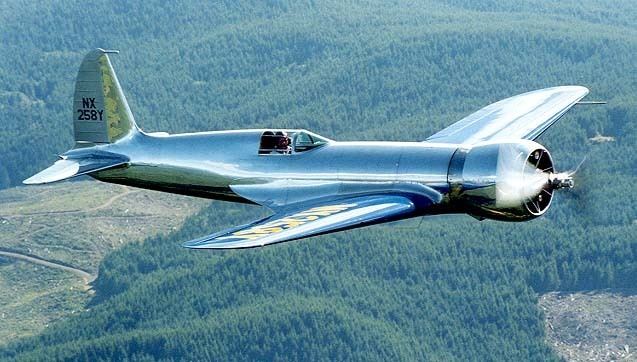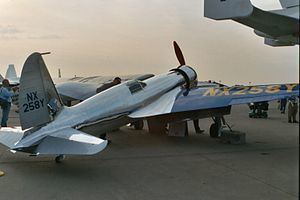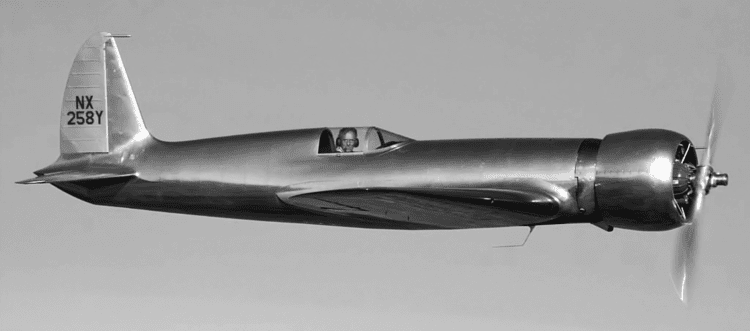Top speed 566 km/h Wingspan 9.67 m Cruise speed 520 km/h | Range 6,437 km Length 8.23 m Manufacturer Hughes Aircraft Company | |
 | ||
Engine type Pratt & Whitney R-1535 Twin Wasp Junior | ||
Hughes h 1 racer the aviator
The Hughes H-1 is a racing aircraft built by Hughes Aircraft in 1935. It set a world airspeed record and a transcontinental speed record across the United States. The H-1 Racer was the last aircraft built by a private individual to set the world speed record; most aircraft to hold the honor since have been military designs.
Contents
- Hughes h 1 racer the aviator
- Maxford usa howard hughes h 1 racer rc scalel model arf v2
- Design and development
- Technical details
- Operational history
- Disposition
- Replicas
- Specifications H 1 Racer original wings
- References

Maxford usa howard hughes h 1 racer rc scalel model arf v2
Design and development

During his work on his movie Hell's Angels, Howard Hughes employed Glenn Odekirk to maintain the fleet of over 100 aircraft used in the production. The two men shared a common interest in aviation and hatched a plan to build a record-beating aircraft. The aircraft was given many names, but is commonly known as the H-1. It was the first aircraft model produced by the Hughes Aircraft company.

Design studies began in 1934 with an exacting, large scale model (over two feet in length) that was tested in the California Institute of Technology wind tunnel, revealing a speed potential of 365 miles per hour (587 km/h).
Technical details

Streamlining was a paramount design criterion resulting in "one of the cleanest and most elegant aircraft designs ever built." Many groundbreaking technologies were developed during the construction process, including individually machined flush rivets that left the aluminium skin of the aircraft completely smooth. The H-1 also had retractable landing gear to further increase the speed of the aircraft, including a fully retractable hydraulically actuated tail skid. It was fitted with a Pratt & Whitney R-1535 twin-row 14-cylinder radial engine of 1,535 cubic inches (25.15 l), which although originally rated at 700 horsepower (522 kW), was tuned to put out over (750 kW)1,000 horsepower (750 kW).

Due to two different roles being envisioned for the racing aircraft, a set of short-span wings for air racing and speed records and a set of "long" wings for cross-country racing were prepared.
Operational history

The H-1 first flew in 1935 and promptly broke the world landplane speed record with Hughes at the controls, clocking 352.39 mph (567.12 km/h) averaged over four timed passes. Hughes apparently ran the aircraft out of fuel and managed to crash-land without serious damage to either himself or the H-1. As soon as Hughes exited the H-1 when he crashed it in a beet field south of Santa Ana, California, his only comment was: "We can fix her; she'll go faster." At the time, the world seaplane speed record was 440.7 mph (709.2 km/h), set by a Macchi M.C.72 in October 1934.
Hughes later implemented minor changes to the H-1 Racer to make it more suitable for a transcontinental speed record attempt. The most significant change was the fitting of a new, longer set of wings that gave the aircraft a lower wing loading. On January 19, 1937, a year and a half after his previous landplane speed record in the H-1, Hughes set a new transcontinental speed record by flying non-stop from Los Angeles to New York City in 7 hours, 28 minutes and 25 seconds. He smashed his own previous record of 9 hours, 27 minutes by two hours. His average speed over the flight was 322 miles per hour (518 km/h).
Considering the contemporary service aircraft were biplanes, Hughes fully expected the United States Army Air Corps (USAAC) to embrace his aircraft's new design and make the H-1 the basis for a new generation of U.S. fighter aircraft. His efforts to "sell" the design were unsuccessful. In postwar testimony before the Senate, Hughes indicated that resistance to the innovative design was the basis for the USAAC rejection of the H-1: "I tried to sell that airplane to the Army but they turned it down because at that time the Army did not think a cantilever monoplane was proper for a pursuit ship..."
Aviation historians have posited that the H-1 Racer may have inspired later radial engine fighters such as the Republic P-47 Thunderbolt and the Focke-Wulf Fw 190. After the war, Hughes further claimed that "it was quite apparent to everyone that the Japanese Zero fighter had been copied from the Hughes H-1 Racer." He noted both the wing shape, the tail design and the general similarity of the Zero and his racer. Jiro Horikoshi, designer of the Mitsubishi Zero strongly denied the allegation of the Hughes H-1 influencing the design of the Japanese fighter aircraft.
The Hughes H-1 Racer is featured in the 1940 RKO Radio Pictures movie Men Against the Sky.
Disposition
The original H-1 Racer was donated to the Smithsonian in 1975 and is on display at the National Air and Space Museum.
Replicas
Jim Wright of Cottage Grove, Oregon built a full-scale replica of the H-1 that he first flew in 2002. His replica was so close to the original that the FAA granted it serial number 2 of the model. His achievement in recreating the aircraft was heralded in virtually every well-known aviation magazine of the time.
On August 4, 2003, Wright unveiled his replica aircraft at the 2003 AirVenture at Oshkosh, Wisconsin. On his way home to Oregon, he refueled the aircraft in Gillette, Wyoming. Wright met briefly with local reporters and said that the aircraft had been having propeller "gear problems." An hour after taking off, the aircraft crashed just north of the Old Faithful Geyser in Yellowstone National Park, killing Wright. The replica, originally slated to be used in the film The Aviator, was completely destroyed. The official accident report detailed a failure of a counterweight on the constant speed propeller. On December 17, 2003, Cottage Grove State Airport was dedicated as Jim Wright Field.
As of 2011, another H-1 replica is being built at the San Diego Air & Space Museum.
Specifications (H-1 Racer, original wings)
Data from "Howard Hughes' H-1: The Search for the Fastest Plane in the World".
General characteristics
Performance
